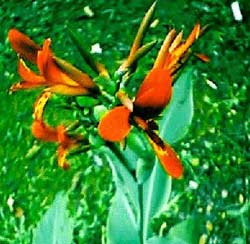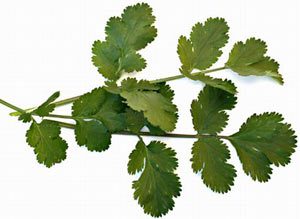Digestive Stimulant Herbs from Your Garden: The herbs and leaves readily available in your garden can help alleviate feelings of fullness and indigestion.
* Chen Pi: This is the dried peel of ripe tangerines from the citrus family. Some people use the peel of certain types of oranges, but that is not Chen Pi. Typically, housewives keep the tangerine peels after eating and hang them in the kitchen until they dry completely. The longer Chen Pi is stored, the better it is.
According to Traditional Chinese Medicine (TCM), Chen Pi has a spicy and bitter taste, with a warm nature affecting the spleen and lungs, helping to regulate qi and harmonize the stomach, and can suppress nausea and vomiting. It is commonly used to treat indigestion, bloating, belching, and diarrhea. Additionally, it helps eliminate phlegm and relieve coughs. The method of use is simple: tear a few pieces of Chen Pi, rinse them with warm water, place them in a cup of boiling water, and steep for 15-20 minutes before consuming. Be sure to drink the infusion while it is still hot and discard the residue.
For treating nausea, belching, and abdominal pain: Use 5g of Chen Pi, 8g of patchouli, and 3 slices of fresh ginger. Boil these ingredients to make a tea.
For cough and loss of voice: Boil 12g of Chen Pi with 200ml of water until 100ml remains, then add sugar to taste and drink throughout the day.
* Galangal:
 |
Galangal Flower (Photo: geocities) |
Also known as greater galangal, it is commonly used as a spice and for medicinal purposes, derived from the stem and roots of the galangal plant, a member of the ginger family. There are various types of galangal in Vietnam, including warm galangal, rhizome galangal, sticky galangal, ginger galangal, and Chinese galangal.
Galangal is an essential spice in several dishes, particularly in shrimp paste, dog meat, and other recipes. It has a spicy and fragrant flavor with a warm nature, stimulating digestion, enhancing appetite, and treating bloating, cold stomach aches, stomach ulcers, malaria, heat fever, and food poisoning. It is sometimes chewed to relieve toothache.
Prescription containing galangal:
To treat upper abdominal pain due to gastric or duodenal ulcers: Use 60g of galangal and 60g of nutgrass rhizome, grind them into powder, mix with honey to form pills, and take 9g daily divided into three doses.
For treating abdominal pain and vomiting: Use 8g of ginger and 1 jujube fruit. Boil with 300ml of water until 100ml remains, divided into 2-3 doses throughout the day.
* Zest and Rind:
These are the dried fruits of trees belonging to the citrus family. Zest is the fruit harvested when still immature and small, while rind is the fruit harvested when it is nearly ripe, typically larger than zest and cut in half for faster drying.
Both zest and rind are common medicinal ingredients in TCM, with a bitter taste, sour nature, and slightly cold properties affecting the spleen and stomach, aiding digestion, eliminating phlegm, treating bloating, promoting urination, and alleviating sweating…
For treating children’s dysentery and irregular eating habits: Dry zest, grind it into powder, and take 3g twice a day.
Zest Decoction: Used for cases of gastric and liver insufficiency leading to constipation: 20g of zest; 6g of white atractylodes; 600ml of water. Boil until only 200ml remains, divided into three doses throughout the day. Zest and rind can also be used to relieve asthma and phlegm.
* Perilla:
Commonly used daily alongside other herbs in fresh salads. Perilla has a spicy flavor, with a warm nature affecting the lungs and spleen. It is a medicinal plant effective for colds, fever, lack of sweating, anti-nausea, enhancing digestion, treating asthma, and helping expel phlegm. It also has detoxifying effects when consuming crabs or fish that may be toxic. When harvesting perilla, be sure to dry it in a cool place or just lightly dry it to prevent the essential oils from evaporating.
For treating poisoning and abdominal pain from eating crab or fish: Use 10g of perilla leaves; 8g of ginger; 4g of licorice; and 600ml of water. Boil until only 200ml remains, divided into three doses throughout the day. Consume while hot.
* Coriander:
 |
Coriander (Photo: toildepices) |
Also known as cilantro, like perilla, coriander is grown everywhere and is a common herb used in meals. Adding a few coriander leaves to stir-fries enhances the dish’s appeal. The whole plant contains essential oils, and both the seeds and roots are used medicinally.
Coriander seeds are used in both TCM and Western medicine. They have a spicy taste and warm properties, helping to disperse, expel phlegm, aid digestion, and relieve gas…
For treating cough, low milk supply, and aiding digestion: Daily use of 4-10g of coriander seeds or 10-20g of fresh leaves, boiled to extract juice or soaked in alcohol.
For measles: In folk medicine, coriander is often used for children with measles that show delayed recovery. Boil about 50g of fresh coriander leaves in 500ml of water, cool slightly, and use a cloth to wipe the child’s body. You can also use 10-12g of coriander seeds boiled for the child to drink or crush a handful of dried seeds, add a little hot alcohol, wrap in thin cloth, and rub on the child’s body.
For treating bloating and gas: Using coriander can help ease flatulence and enhance appetite.
For treating diarrhea: Use about 8g of coriander seeds in one day, roast until fragrant, and drink with water.
Dr. THANH QUÝ


















































